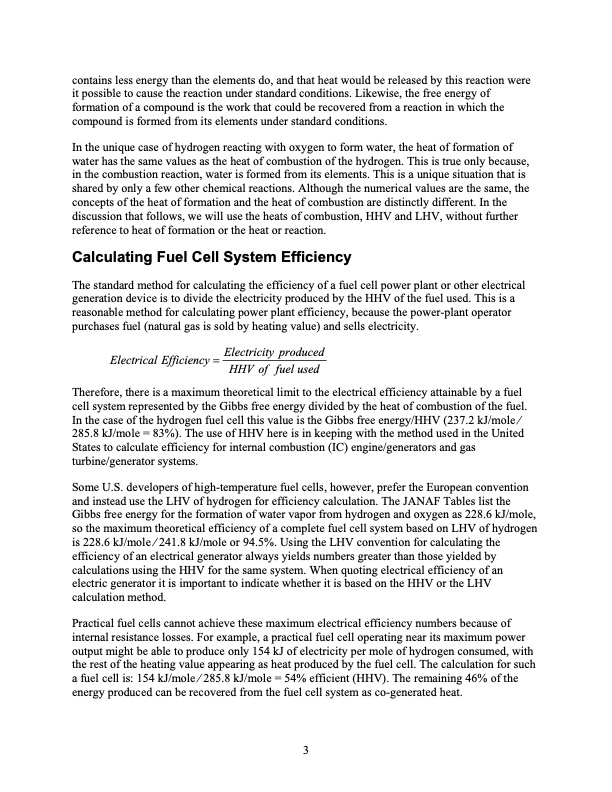
PDF Publication Title:
Text from PDF Page: 007
contains less energy than the elements do, and that heat would be released by this reaction were it possible to cause the reaction under standard conditions. Likewise, the free energy of formation of a compound is the work that could be recovered from a reaction in which the compound is formed from its elements under standard conditions. In the unique case of hydrogen reacting with oxygen to form water, the heat of formation of water has the same values as the heat of combustion of the hydrogen. This is true only because, in the combustion reaction, water is formed from its elements. This is a unique situation that is shared by only a few other chemical reactions. Although the numerical values are the same, the concepts of the heat of formation and the heat of combustion are distinctly different. In the discussion that follows, we will use the heats of combustion, HHV and LHV, without further reference to heat of formation or the heat or reaction. Calculating Fuel Cell System Efficiency The standard method for calculating the efficiency of a fuel cell power plant or other electrical generation device is to divide the electricity produced by the HHV of the fuel used. This is a reasonable method for calculating power plant efficiency, because the power-plant operator purchases fuel (natural gas is sold by heating value) and sells electricity. Electrical Efficiency = Electricity produced HHV of fuel used Therefore, there is a maximum theoretical limit to the electrical efficiency attainable by a fuel cell system represented by the Gibbs free energy divided by the heat of combustion of the fuel. In the case of the hydrogen fuel cell this value is the Gibbs free energy/HHV (237.2 kJ/mole ∕ 285.8 kJ/mole = 83%). The use of HHV here is in keeping with the method used in the United States to calculate efficiency for internal combustion (IC) engine/generators and gas turbine/generator systems. Some U.S. developers of high-temperature fuel cells, however, prefer the European convention and instead use the LHV of hydrogen for efficiency calculation. The JANAF Tables list the Gibbs free energy for the formation of water vapor from hydrogen and oxygen as 228.6 kJ/mole, so the maximum theoretical efficiency of a complete fuel cell system based on LHV of hydrogen is 228.6 kJ/mole ∕ 241.8 kJ/mole or 94.5%. Using the LHV convention for calculating the efficiency of an electrical generator always yields numbers greater than those yielded by calculations using the HHV for the same system. When quoting electrical efficiency of an electric generator it is important to indicate whether it is based on the HHV or the LHV calculation method. Practical fuel cells cannot achieve these maximum electrical efficiency numbers because of internal resistance losses. For example, a practical fuel cell operating near its maximum power output might be able to produce only 154 kJ of electricity per mole of hydrogen consumed, with the rest of the heating value appearing as heat produced by the fuel cell. The calculation for such a fuel cell is: 154 kJ/mole ∕ 285.8 kJ/mole = 54% efficient (HHV). The remaining 46% of the energy produced can be recovered from the fuel cell system as co-generated heat. 3PDF Image | Hydrogen Production: Fundamentals

PDF Search Title:
Hydrogen Production: FundamentalsOriginal File Name Searched:
47302.pdfDIY PDF Search: Google It | Yahoo | Bing
NFT (Non Fungible Token): Buy our tech, design, development or system NFT and become part of our tech NFT network... More Info
IT XR Project Redstone NFT Available for Sale: NFT for high tech turbine design with one part 3D printed counter-rotating energy turbine. Be part of the future with this NFT. Can be bought and sold but only one design NFT exists. Royalties go to the developer (Infinity) to keep enhancing design and applications... More Info
Infinity Turbine IT XR Project Redstone Design: NFT for sale... NFT for high tech turbine design with one part 3D printed counter-rotating energy turbine. Includes all rights to this turbine design, including license for Fluid Handling Block I and II for the turbine assembly and housing. The NFT includes the blueprints (cad/cam), revenue streams, and all future development of the IT XR Project Redstone... More Info
Infinity Turbine ROT Radial Outflow Turbine 24 Design and Worldwide Rights: NFT for sale... NFT for the ROT 24 energy turbine. Be part of the future with this NFT. This design can be bought and sold but only one design NFT exists. You may manufacture the unit, or get the revenues from its sale from Infinity Turbine. Royalties go to the developer (Infinity) to keep enhancing design and applications... More Info
Infinity Supercritical CO2 10 Liter Extractor Design and Worldwide Rights: The Infinity Supercritical 10L CO2 extractor is for botanical oil extraction, which is rich in terpenes and can produce shelf ready full spectrum oil. With over 5 years of development, this industry leader mature extractor machine has been sold since 2015 and is part of many profitable businesses. The process can also be used for electrowinning, e-waste recycling, and lithium battery recycling, gold mining electronic wastes, precious metals. CO2 can also be used in a reverse fuel cell with nafion to make a gas-to-liquids fuel, such as methanol, ethanol and butanol or ethylene. Supercritical CO2 has also been used for treating nafion to make it more effective catalyst. This NFT is for the purchase of worldwide rights which includes the design. More Info
NFT (Non Fungible Token): Buy our tech, design, development or system NFT and become part of our tech NFT network... More Info
Infinity Turbine Products: Special for this month, any plans are $10,000 for complete Cad/Cam blueprints. License is for one build. Try before you buy a production license. May pay by Bitcoin or other Crypto. Products Page... More Info
| CONTACT TEL: 608-238-6001 Email: greg@infinityturbine.com | RSS | AMP |